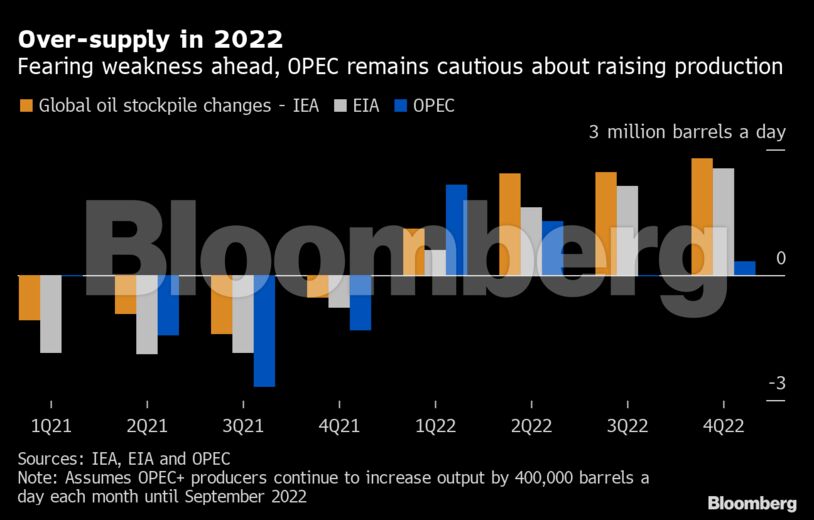By Julian Lee

Looking at the chart above, it is easy to see why the OPEC+ oil ministers were reluctant to boost supply by more than the planned 400,000 barrels a day when they met at the beginning of the month. All three forecasters agree that the steepest oil stock draws are behind us and that, if the producer group keeps adding supply at the same rate in the coming months, global oil inventories will start to swell again next year. And that’s even after demand gets a winter boost from fuel switching prompted by high-priced natural gas.
But behind this broad agreement, there are stark differences in the detailed views of the three agencies. While their annual average oil demand forecasts for 2021 have stabilized — no great surprise with most of the year now behind us — significant differences remain in their quarter-by-quarter views.
OPEC analysts have a much more pessimistic view of the start of 2021, seeing the world’s need for their members’ crude more than 1 million barrels a day lower than the volume assessed by the IEA. But that pessimism turns to a more positive outlook in subsequent quarters, with the producer group seeing the call on its crude between 500,000 barrels and 1.26 million barrels a day higher than the consumer group’s analysts.

Given that they are supposedly measuring the same things, using much of the same raw data, it is surprising that there are such large differences for the historical assessments. But those differences illustrate why oil markets are volatile, if the world’s biggest forecasting organizations cannot even agree on what happened in the past, let alone what will happen in the future.
Turning to that future, OPEC analysts are alone in seeing a brief period of demand weakness in the first quarter of next year, but that’s followed by strong growth for the rest of the year, taking its demand outlook from the weakest to the strongest of the three agencies by the second half of the year.
That strength in oil demand growth, coupled with the lowest forecasts for non-OPEC crude supply over the two summer quarters next year, sets OPEC up for the strongest of the three forecasts of the world’s need for the group’s crude in the second half of 2022. By that time, the oil market is in balance, with supply matching demand, according to OPEC’s analysts.
That’s in stark contrast with the views from the other two agencies. Both the IEA and the EIA see global oil supply running well ahead of demand from the second quarter of 2022 onward, with the excess approaching 3 million barrels a day by the end of the year.
With those forecasts of surpluses next year, it’s easy to see why the oil producers group remains cautious about adding more supply than they have already planned. But with oil stockpiles already well below their target level of the 2015-2019 average, we still have to get through the winter first.
Share This:




 CDN NEWS |
CDN NEWS |  US NEWS
US NEWS 





























